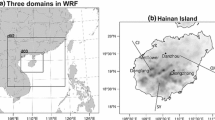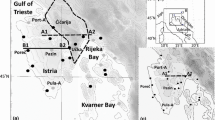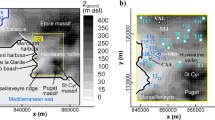Abstract
The genesis and evolution of a sea-breeze front associated with a shallow convection episode at Fuerteventura Island (Canaries archipelago) are investigated using the Weather Research and Forecasting (WRF) numerical model. Three local and two non-local planetary boundary layer (PBL) parametrization schemes are used, and results of the numerical simulations are compared with observations from the local meteorological surface station network. Statistical analysis shows a good agreement between simulations and measurements, in particular for the 2-m temperature. These results are used in choosing the final PBL scheme and its coupled surface-layer scheme, which is used to simulate the daytime period of the sea-breeze development and weakening. During this episode, a sea-breeze front moved inland against a prevailing offshore flow 3 h after sunrise, colliding with a downslope flow near the centre of the island. The convergence of both flows from opposing directions produced a strong updraft, forming shallow convection a few hours later.












Similar content being viewed by others
Notes
European Centre for Medium-Range Weather Forecasts (2009): ERA-Interim Project. Research Data Archive at the National Center for Atmospheric Research, Computational and Information Systems Laboratory. Dataset. https://doi.org/10.5065/D6CR5RD9. Accessed† 29 May 2017.
NASA Goddard Space Flight Center, Ocean Ecology Laboratory, Ocean Biology Processing Group. Moderate-resolution Imaging Spectroradiometer (MODIS) Aqua Sea Surface Temperature Data; 2014 Reprocessing. NASA OB. DAAC, Greenbelt, MD, USA. http://dx.doi.org/10.5067/AQUA/MODIS/L3B/SST/2014. Accessed on 23 May 2017.
References
Arrillaga JA, Yagüe C, Sastre M, Román-Cascón C (2016) A characterisation of sea-breeze events in the eastern Cantabrian coast (Spain) from observational data and WRF simulations. Atmos Res 181:265–280
Azorin-Molina C, Tijm S, Ebert EE, Vicente-Serrano S-M, Estrela M-J (2015) High resolution HIRLAM simulations of the role of low-level sea-breeze convergence in initiating deep moist convection in the eastern Iberian Peninsula. Boundary-Layer Meteorol 154:81–100
Banks RF, Tiana-Alsina J, Baldasano JM, Rocadenbosch F, Papayannis A, Solomos S, Tzanis CG (2016) Sensitivity of boundary-layer variables to PBL schemes in the WRF model based on surface meteorological observations, lidar, and radiosondes during the HygrA-CD campaign. Atmos Res 176–177:185–201
Buckley RL, Weber AH, Weber JH (2004) Statistical comparison of regional atmospheric modelling system forecast with observations. Meteorol Appl 11:67–82
Calmet I, Mestayer PG, Van Eijk AMJ, Herlédant O (2018) A coastal bay summer breeze study, part 2: high-resolution numerical simulation of sea-breeze local influences. Boundary-Layer Meteorol 167:27–51
Carrillo J, Guerra JC, Cuevas E, Barrancos J (2016) Characterization of the marine boundary layer and the trade-wind inversion over the sub-tropical North Atlantic. Boundary-Layer Meteorol 158:311–330
Chen F, Dudhia J (2001) Coupling an advanced land surface–hydrology model with the Penn State–NCAR MM5 modeling system. Part II: preliminary model validation. Mon Weather Rev 129:587–604
Cohen AE, Cavallo SM, Coniglio MC, Brooks HE (2015) A review of planetary boundary layer parameterization schemes and their sensitivity in simulating southeastern U.S. cold season severe weather environments. Weather Forecast 30:591–612
Crosman ET, Horel JD (2010) Sea and lake breezes: a review of numerical studies. Boundary-Layer Meteorol 137:1–29
Dailey PS, Fovell RG (1999) Numerical simulation of the interaction between the sea-breeze front and horizontal convective rolls. Part I: offshore ambient flow. Mon Weather Rev 127:858–878
Dalu GA, Pielke RA (1989) An analytical study of the sea breeze. J Atmos Sci 46:1815–1825
Dandou A, Tombrou M, Kalogiros J, Bossioli E, Biskos G, Mihalopoulos N, Coe H (2017) Investigation of turbulence parametrization schemes with reference to the atmospheric boundary layer over the Aegean Sea during etesian winds. Boundary-Layer Meteorol 164:303–329
Dimitrova R, Silver Z, Zsedrovits T, Hocut CM, Leo LS, Di Sabatino S, Fernando HJS (2016) Assessment of planetary boundary-layer schemes in the Weather Research and Forecasting Mesoscale Model using MATERHORN field data. Boundary-Layer Meteorol 159:589–609
Ferrero E, Alessandrini S, Vandenberghe F (2018) Assessment of planetary-boundary-layer schemes in the Weather Research and Forecasting Model within and above an urban canopy layer. Boundary-Layer Meteorol 168:289–319
Fovell RG (2005) Convective initiation ahead of the sea-breeze front. Mon Weather Rev 133:264–278
Fovell RG, Dailey PS (2001) Numerical simulation of the interaction between the sea-breeze front and horizontal convective rolls. Part II: alongshore ambient flow. Mon Weather Rev 129:2057–2072
Garratt J (1990) The internal boundary layer—a review. Boundary-Layer Meteorol 50:171–203
Gibbs JA, Fedorovich E, Van Eijk AMJ (2011) Evaluating weather research and forecasting (WRF) model predictions of turbulent flow parameters in a dry convective boundary layer. J Appl Meteorol Climatol 50:2429–2444
Gilliam RC, Pleim JE (2010) Performance assessment of new land surface and planetary boundary layer physics in the WRF-ARW. J Appl Meteorol Climatol 49:760–774
Grell GA, Dévényi D (2002) A generalized approach to parameterizing convection combining ensemble and data assimilation techniques. Geophys Res Lett 29:38-1–38-4
Grenier H, Bretherton CS (2001) A moist PBL parameterization for large-scale models and its application to subtropical cloud-topped marine boundary layers. Mon Weather Rev 129:357–377
Gunwani P, Mohan M (2017) Sensitivity of WRF model estimates to various PBL parameterizations in different climatic zones over India. Atmos Res 194:43–65
Hernández-Guerra A, Machín F, Antoranz A, Cisneros-Aguirre J, Gordo C, Marrero-Díaz A, Martínez A, Ratsimandresy A-W, Rodríguez-Santana A, Sangrá P, López-Laazen F, Parrilla G, Pelegrí JL (2002) Temporal variability of mass transport in the Canary Current. Deep Sea Res II 49:3415–3426
Hong S-Y, Noh Y, Dudhia J (2006) A new vertical diffusion package with an explicit treatment of entrainment processes. Mon Weather Rev 134:2318–2341
Huang H-Y, Hall A, Teixeira J (2013) Evaluation of the WRF PBL parameterizations for marine boundary layer clouds: cumulus and stratocumulus. Mon Weather Rev 141:2265–2271
Huang Q-Q, Cai X-H, Song Y, Kang L (2016) A numerical study of sea breeze and spatiotemporal variation in the coastal atmospheric boundary layer at Hainan Island, China. Boundary-Layer Meteorol 161:543–560
Hughes CP, Veron DE (2018) A characterization of the Delaware sea breeze using observations and modeling. J Appl Meteorol Climatol 57:1405–1421
Janjić ZI (1994) The step-mountain eta coordinate model: further developments of the convection, viscous sublayer and turbulence closure schemes. Mon Weather Rev 122:927–945
Jiménez PA, Dudhia J, González-Rouco JF, Navarro J, Montávez JP, García-Bustamante E (2012) A revised scheme for the WRF surface layer formulation. Mon Weather Rev 140:898–918
Jousse A, Hall A, Sun F, Teixeira J (2016) Causes of WRF surface energy fluxes biases in a stratocumulus region. Clim Dyn 46:571–584
Kirshbaum DJ, Adler B, Kalthoff N, Barthlott C, Serafin S (2018) Moist orographic convection: physical mechanisms and links to surface-exchange processes. Atmosphere 9(80):1–26
Kwun JH, Kim Y-K, Seo J-W, Jeong JH, You SH (2009) Sensitivity of MM5 and WRF mesoscale model predictions of surface winds in a typhoon to planetary boundary layer parameterizations. Nat Hazards 51:63–77
Lin Y-L, Farley RD, Orville HD (1983) Bulk parameterization of the snow field in a cloud model. J Clim Appl Meteorol 22:1065–1092
Lombardo K, Sinsky E, Edson J, Whitney MM, Jia Y (2018) Sensitivity of offshore surface fluxes and sea breezes to the spatial distribution of sea-surface temperature. Boundary-Layer Meteorol 166:475–502
Miller STK, Keim BD, Talbot RW, Mao H (2003) Sea breeze: structure, forecasting, and impacts. Rev Geophys 41:1–31
Mlawer EJ, Taubman SJ, Brown PD, Iacono MJ, Clough SA (1997) Radiative transfer for inhomogeneous atmospheres: RRTM, a validated correlated-k model for the longwave. J Geophys Res Atmos 102:16663–16682
Nakanishi M, Niino H (2006) An improved Mellor-Yamada Level-3 model: its numerical stability and application to a regional prediction of advection fog. Boundary-Layer Meteorol 119:397–407
Nunalee C, Basu S (2014) Wind energy—impact of turbulence. Res Top Wind Energy 2:197–202
Pleim JE (2007) A combined local and nonlocal closure model for the atmospheric boundary layer. Part I: model description and testing. J Appl Meteorol Climatol 46:1383–1395
Pleim JE, Xiu A (1995) Development and testing of a surface flux and planetary boundary layer model for application in mesoscale models. J Appl Meteorol 34:16–32
Qian T, Epifanio CC, Zhang F (2012) Topographic effects on the tropical land and sea breeze. J Atmos Sci 69:130–149
Rotunno R (1983) On the linear theory of the land and sea breeze. J Atmos Sci 40:1999–2009
Skamarock WC, Klemp JB, Dudhia J, Gill DO, Barker DM, Duda M, Huang X-Y, Wang W, Powers JG (2008) A description of the advanced research WRF version 3. NCAR Technical Note, NCAR/TN-468 + STR
Smith EN, Gibbs JA, Fedorovich E, Klein P (2018) WRF model study of the Great Plains low-level jet: effects of grid spacing and boundary layer parameterization. J Appl Meteorol 57:2375–2397
Smolarkievicz PK, Rassmussen RM, Clark TL (1988) On the dynamics of Hawaiian cloud bands: Island forcing. J Atmos Sci 45:1872–1905
Soderholm B, Ronalds B, Kirshbaum DJ (2014) The evolution of convective storms initiated by an isolated mountain ridge. Mon Weather Rev 142:1430–1451
Soriano C, Jorba O, Baldasano JM (2004) One-way nesting versus two-way nesting: does it really make a difference? In: Borrego C, Schayes G (eds) Air pollution modeling and its application XV. Springer, Boston, MA
Stull RB (1991) Static stability—an update. Bull Am Meteorol Soc 72:1521–1529
Tymvios F, Charalambous D, Michaelides S, Lelieveld J (2018) Intercomparison of boundary layer parameterizations for summer conditions in the eastern Mediterranean island of Cyprus using the WRF–ARW model. Atmos Res 208:45–59
Wang CC, Kirshbaum DJ (2015) Thermally forced convection over a mountainous tropical island. J Atmos Sci 72:2484–2506
Wang CC, Kirshbaum DJ (2017) Idealized simulations of sea breezes over mountainous islands. Q J R Meteorol Soc 143:1657–1669
Xian Z, Pielke RA (1991) The effects of width of landmasses on the development of sea breezes. J Appl Meteorol 30:1280–1304
Yver CE, Graven HD, Lucas DD, Cameron-Smith PJ, Keeling RF, Weiss RF (2013) Evaluating transport in the WRF model along the California coast. Atmos Chem Phys 13:1837–1852
Acknowledgements
This article is a publication of the Unidad Océano y Clima of the Universidad de Las Palmas de Gran Canaria, a R&D&i CSIC‐associate unit. This research has been supported by RIS-3 PO Feder Canarias through project BOUNDARY (ProID2017010083). All plots where created by NCAR Command Language (NCL)(The NCAR Command Language (Version 6.6.2) [Software]. 2019. Boulder, Colorado: UCAR/NCAR/CISL/TDD. http://dx.doi.org/10.5065/D6WD3XH5). The authors also thank the anonymous reviewers for their insightful comments, which helped to improve this article.
Author information
Authors and Affiliations
Corresponding author
Additional information
Publisher's Note
Springer Nature remains neutral with regard to jurisdictional claims in published maps and institutional affiliations.
Appendix
Appendix
See Table 5.
Rights and permissions
About this article
Cite this article
Cana, L., Grisolía-Santos, D. & Hernández-Guerra, A. A Numerical Study of a Sea Breeze at Fuerteventura Island, Canary Islands, Spain. Boundary-Layer Meteorol 175, 277–296 (2020). https://doi.org/10.1007/s10546-020-00506-z
Received:
Accepted:
Published:
Issue Date:
DOI: https://doi.org/10.1007/s10546-020-00506-z




